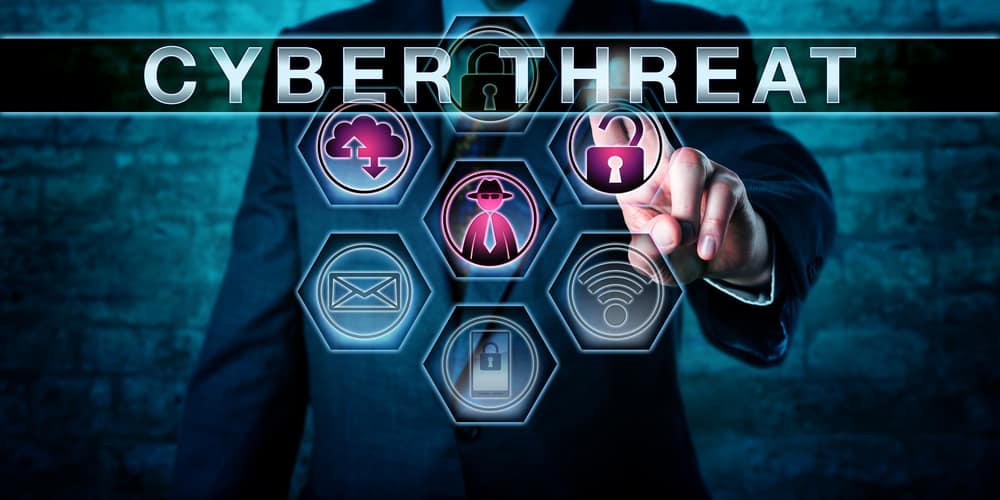Cyber threats have become an increasingly prevalent issue in the digital age. This article will examine some of the most common types of cyber threats, including:
- Malware
- Phishing
- DDoS attacks
- Social engineering attacks
- Man-in-the-middle attacks
- Identity theft
- SQL injection
- Data breaches
Additionally, this article will discuss current issues related to Internet of Things (IoT) security concerns.

Key Takeaways
- Identity theft and phishing are two common types of cyber threats that individuals and organizations need to be aware of. It is important to take steps to protect personal information and educate employees on how to identify and report suspicious activity.
- Data breaches and ransomware attacks can lead to significant financial losses and disruption of services. Organizations should invest in robust security measures such as malware prevention, data encryption, and regular backups to protect sensitive information.
- SQL injection and man-in-the-middle attacks are specific techniques used by cybercriminals to gain unauthorized access to databases and intercept communications. Developers should secure applications and regularly audit databases for suspicious activity.
- IoT security concerns and social engineering are emerging cyber threats that organizations need to address. Implementing strong authentication protocols, firewalls, and monitoring network activity can help mitigate risks. Educating employees on social engineering tactics and implementing multi-factor authentication are also important measures to prevent unauthorized access to information.
Malware
Malware is a type of malicious software used to gain unauthorized access to digital devices or networks. As the use of technology becomes increasingly pervasive, malware poses a threat to both private and public organizations. Malware is designed to disrupt, damage, or gain access to confidential information for malicious intent. It can be spread through email attachments, links on websites, and even physical media such as USB drives or CDs.
While malware prevention can be difficult due to its ability to quickly evolve and adapt, there are steps that individuals and organizations can take in order to protect their computer systems from attack.

One way of mitigating the risk posed by malware is installing antivirus software that actively scans for suspicious files and automatically wipes out any malicious code it finds. Additionally, users should exercise caution when downloading files from untrusted sources or clicking on suspicious links in emails or messages sent over social media platforms.
Organizations should also implement strict security protocols such as firewalls that monitor incoming traffic for signs of potential attacks, and enforce policies such as two-factor authentication which make it more difficult for attackers to gain access even if they have obtained passwords.
Overall, malware continues to pose a significant threat in today’s world where reliance on digital technologies is high. However, with appropriate measures taken by individuals and organizations alike, the risk posed by malicious software can be effectively mitigated.
Phishing
Phishing is a common form of cyberattack that involves the use of fraudulent emails or websites to gain access to sensitive information. This type of attack uses various techniques, such as email spoofing and web skimming, in order to deceive victims into providing confidential data. Phishing attacks are typically carried out by sending deceptive and convincing messages that appear to come from legitimate sources. These messages often contain malicious links or attachments containing malware that can be used for stealing passwords, financial information, and other personal details.
The impact of phishing attacks on organizations is significant since they can lead to financial losses, reputational damage, and disruption of services. They can also result in data breaches which have severe implications for customers’ privacy and security. Furthermore, it is difficult for organizations to detect these attacks due to their sophisticated nature.
To defend against phishing attacks, organizations need to implement rigorous security measures such as multi-factor authentication for user accounts; using secure networks with firewalls; conducting regular security audits; educating employees about cyber threats; deploying anti-phishing software; and monitoring suspicious activities within their systems.
It is also essential for individuals to take proactive steps such as being wary of unexpected emails with attachments or links from unknown sources; creating strong passwords; enabling two-factor authentication whenever possible; avoiding suspicious websites that ask for personal information; installing antivirus software on all devices used online; and keeping all software up-to-date.
Phishing remains one of the most common forms of cyberattacks today due to its low cost and high success rate in obtaining confidential data from unsuspecting victims. Organizations must invest in effective measures to protect themselves against this increasingly pervasive threat while individuals should practice good cyber hygiene habits at all times in order to reduce their risk exposure online.
DDoS Attacks
Distributed Denial of Service (DDoS) attacks are a malicious form of attack that involves bombarding a computer network or system with a large amount of data traffic in order to overwhelm it and cause it to become unavailable. DDoS attacks are becoming increasingly common, as they offer attackers the opportunity to disrupt computer networks without having direct access.
The goal of these attacks is typically to render the target’s service or website inaccessible by flooding them with an overwhelming amount of data traffic from multiple sources. As such, they can have serious repercussions for organizations that rely on their website and services for operations.
The most significant factor contributing to successful DDoS attacks is network vulnerabilities. Attackers often exploit weaknesses in the security measures put in place by organizations, making it easy for them to launch their attacks. Additionally, cloud security has become more important than ever due to the prevalence of distributed computing and storage systems. By securing cloud-based systems against DDoS threats, organizations can reduce their risks greatly.

Organizations should take steps now to mitigate their exposure to DDoS attacks by identifying potential points of vulnerability and implementing appropriate countermeasures such as firewalls, intrusion detection systems, and failover solutions. They should also ensure that all components of their networks are properly configured and regularly monitored for suspicious activity. Finally, investing in cloud security solutions will help protect against this type of threat while providing additional layers of protection should an attack occur.
Social Engineering Attacks
Social engineering attacks utilize deception and manipulation tactics to gain access to sensitive information or resources. This type of attack is one of the most common cyber threats used by malicious actors, as it relies heavily on exploiting human behavior and emotions instead of technological vulnerabilities.
Social engineering scams are usually conducted via email or phone, where attackers use convincing stories to manipulate targets into providing confidential information or transferring money. In some cases, attackers may even deploy virtual extortion techniques such as ransomware to demand payment from victims in exchange for restoring their data.
A successful social engineering attack requires the attacker to be extremely persuasive and knowledgeable about the target’s interests, preferences, and habits in order to create a believable story that can be used for exploitation. Attackers generally rely on a combination of fear tactics combined with promises of rewards in order to convince targets to take action that would benefit the attacker. For example, an attacker may claim that they have incriminating evidence against the target and offer money in exchange for compromising information.
However, there are several steps individuals can take to mitigate social engineering attacks. Firstly, users should be educated about the potential risks posed by cybercriminals and be aware of any suspicious communication received online or over the phone. Additionally, organizations should ensure their employees are equipped with security policies which should be regularly updated and enforced at all levels within an organization. Finally, robust authentication procedures must be implemented across all networks so that only authorized personnel have access to sensitive data or resources within an organization’s systems.
Man-in-the-Middle Attacks
Man-in-the-middle attacks are a form of attack in which an unauthorized third party intercepts communications between two parties, allowing them to gain access to confidential data. This type of attack works by exploiting vulnerabilities in the network interception process. An attacker can impersonate both parties to the communication, making each believe they are communicating with the other while actually controlling the exchange.
This form of cyber threat is particularly insidious as it allows attackers to conduct various types of fraud and deception without either party being aware. It can be used to spoof emails, masquerade as someone else online, or intercept and alter messages sent between two devices. For instance, an attacker could use this technique to steal credit card information or hijack user sessions on a website.
The best defense against Man-in-the-Middle attacks is through strong authentication protocols that verify the identity of each participant in a transaction before any data is transferred. Additionally, encryption should be implemented whenever possible when transmitting sensitive information over networks so that even if an attacker does manage to gain access to data, it will be unreadable and unusable for them.
Finally, users must remain vigilant with online activities and monitor their accounts regularly for suspicious activity.
Identity Theft
Moving on from Man-in-the-Middle Attacks, another form of cyber threat is Identity Theft. This type of online crime occurs when an individual or group steals personal information about someone else without their knowledge or permission. It can be used for financial gain, such as opening credit cards and bank accounts in another person’s name, or for malicious purposes like taking over a person’s social media accounts or online identity. Identity theft can also include using stolen data to commit other cybercrimes such as fraud and sabotage.
To combat this growing problem, governments around the world are introducing new legislation to protect individuals against online scams and identity theft. These laws are designed to provide legal recourse for victims of cybercrime, make it easier to prosecute offenders, and help establish guidelines for companies that collect and store personal information online. Additionally, organizations are working with law enforcement agencies to investigate cases of identity theft more quickly and efficiently so that perpetrators can be brought to justice swiftly.
Individuals can also take steps to protect themselves from becoming victims of identity theft by regularly checking their credit reports; not giving out personal information over email; keeping track of their financial statements; being aware of phishing scams; using strong passwords; avoiding suspicious links; enabling two-factor authentication wherever possible; limiting access on shared devices; and making sure their computers have up-to-date antivirus software installed. By employing these strategies, people can reduce the chances they will become targets of this type of cybercrime.
Identity theft is a serious concern in today’s digital age due its ability to cause significant financial harm as well as psychological distress for victims who often experience feelings of betrayal in addition to material losses. While there is no single solution that guarantees complete protection from all types of cyber threats, raising public awareness about best practices for staying safe online combined with improved government regulations may help reduce the prevalence of identity theft in years ahead.
SQL Injection
SQL Injection is an attack technique used by malicious actors to gain access to and manipulate databases. It works by using specially crafted SQL statements, which are inserted into a form field or parameter in order to execute the code. These attacks can be initiated from any system connected to the Database Management System (DBMS), making it difficult for most organizations to detect them. As such, organizations should focus on proper Ransomware protection and Network monitoring measures as key components of their cybersecurity strategy.
The primary goal of an SQL injection attack is to gain unauthorized access to sensitive data stored in the DBMS, allowing attackers to steal personal information such as credit card numbers and passwords. Additionally, they can use this same technique to modify or delete data, thus causing irreparable damage and disruption of services. To mitigate these risks, developers must be aware of the potential threats posed by SQL injection attacks and take steps to secure their applications accordingly. This includes ensuring that input fields are properly sanitized before accepting user input and implementing proper authentication mechanisms for validating users’ credentials.
In addition, administrators should regularly audit their databases for anomalies that may indicate an attempted attack has taken place. This includes looking out for suspicious queries or attempts at unauthorized access that may have been made through vulnerable web application forms or other means. By doing so, they can ensure that any malicious activity is detected quickly and dealt with promptly before serious damage has been done.
Organizations today face a variety of cyber threats including SQL injection attacks; however, with proper security measures in place they can greatly reduce the risk of suffering from this type of attack while also protecting their valuable data assets from being exposed or corrupted by outside sources.
Data Breaches
Data breaches involve the unauthorized access to sensitive information, often resulting in significant financial losses and reputational damage. Cybercriminals have become increasingly sophisticated in their methods, utilizing malware such as Trojans, spyware, ransomware and other malicious code to gain access to confidential data held by organizations. In some cases, attackers may also exploit existing vulnerabilities in an organization’s security infrastructure or use social engineering tactics to fool unsuspecting users into providing their passwords or other confidential information.
As a result, organizations need to implement robust strategies for protecting their networks and data from these threats. This includes investing in malware prevention solutions, implementing data encryption technology and educating employees on cybersecurity best practices.
Organizations should also take steps to detect any suspicious activity on their systems that could indicate a breach has taken place. This can include monitoring network traffic for anomalies, scanning for suspicious files or processes running on the system and scanning email messages for malicious attachments or links. Additionally, regular backups of all critical data should be completed so that it can be restored if a breach occurs.
By taking proactive steps to protect against cyber threats and mitigate the risk of a data breach occurring, organizations can help ensure the integrity of their networks and safeguard sensitive information from falling into the wrong hands.
IoT Security Concerns
The Internet of Things (IoT) is becoming increasingly popular, yet it also presents a range of security risks for organizations. IoT devices are often interconnected with cloud computing systems and can store large amounts of data, making them potential targets for malicious actors. In addition to external threats, organizations must also be aware of the potential insider threat posed by employees accessing sensitive information stored on these devices.
As such, it is critical that appropriate measures are taken to secure IoT technology in order to protect an organization’s assets and prevent unauthorized access.
Organizations should implement robust authentication protocols to protect their networks from unauthorized access. Furthermore, they should set up firewalls and other security measures to monitor and detect suspicious activity taking place within their network infrastructure. Additionally, companies should ensure that all users have unique passwords and regularly update their software in order to address any newly discovered vulnerabilities.
It is also important for companies to provide staff with regular training regarding cybersecurity best practices in order to reduce the risk of human error causing a data breach or hack.
Organizations must take the necessary steps to secure their IoT networks as failure to do so could lead not only financial losses but serious damage to their reputation as well. By implementing the right security protocols and providing ongoing training for employees, companies can mitigate many common cyber threats associated with IoT technology and ensure the safety of both customer data and organizational assets alike.
Frequently Asked Questions
How can I protect myself from cyber threats?
To protect oneself from cyber threats, one should stay informed of the latest online scams and malicious software. Being aware of any suspicious emails or messages as well as updating security measures regularly is a must. Additionally, using strong passwords and never sharing personal information can help minimize potential risks.
What technologies can be used to detect cyber threats?
Cloud monitoring and network scanning are two technologies used to detect cyber threats. These tools allow companies to identify malicious activity, monitor access, and detect suspicious behavior. Such measures provide insights into security vulnerabilities and help reduce the risk of a breach.
What is the best way to recover from a cyber attack?
The best way to recover from a cyber attack is through an effective malware prevention strategy and data restoration. This should include frequent backups, regular security updates, and secure authentication protocols to minimize the risk of re-infection.
What is the difference between cyber security and cyber safety?
Cyber Security is concerned with protecting data and systems from unauthorised access, while Cyber Safety focuses on preventing malicious attacks such as phishing scams. Both are essential for keeping digital information and users safe from threats.
What are the most common forms of cybercrime?
Exploring cybercrime, it is evident that social engineering and malicious hacking are the most common forms. These methods can be used to gain access to sensitive data or disrupt networks. The sophistication of these attacks continues to evolve, making them difficult to detect and counter.
Conclusion
Cyber threats are a growing concern, as they can cause serious damage to businesses and individuals. Malware, phishing, DDoS attacks, social engineering attacks, man-in-the-middle attacks, identity theft, SQL injection and data breaches are some of the most common forms of cybercrime.
It is essential that both organizations and individuals take steps to protect themselves against these malicious acts. This can be achieved by being aware of the latest trends in cyber security technology and updating their systems regularly to protect themselves from potential attacks.
Ultimately, it is important to remain vigilant in order to minimize risk and ensure secure operations.
